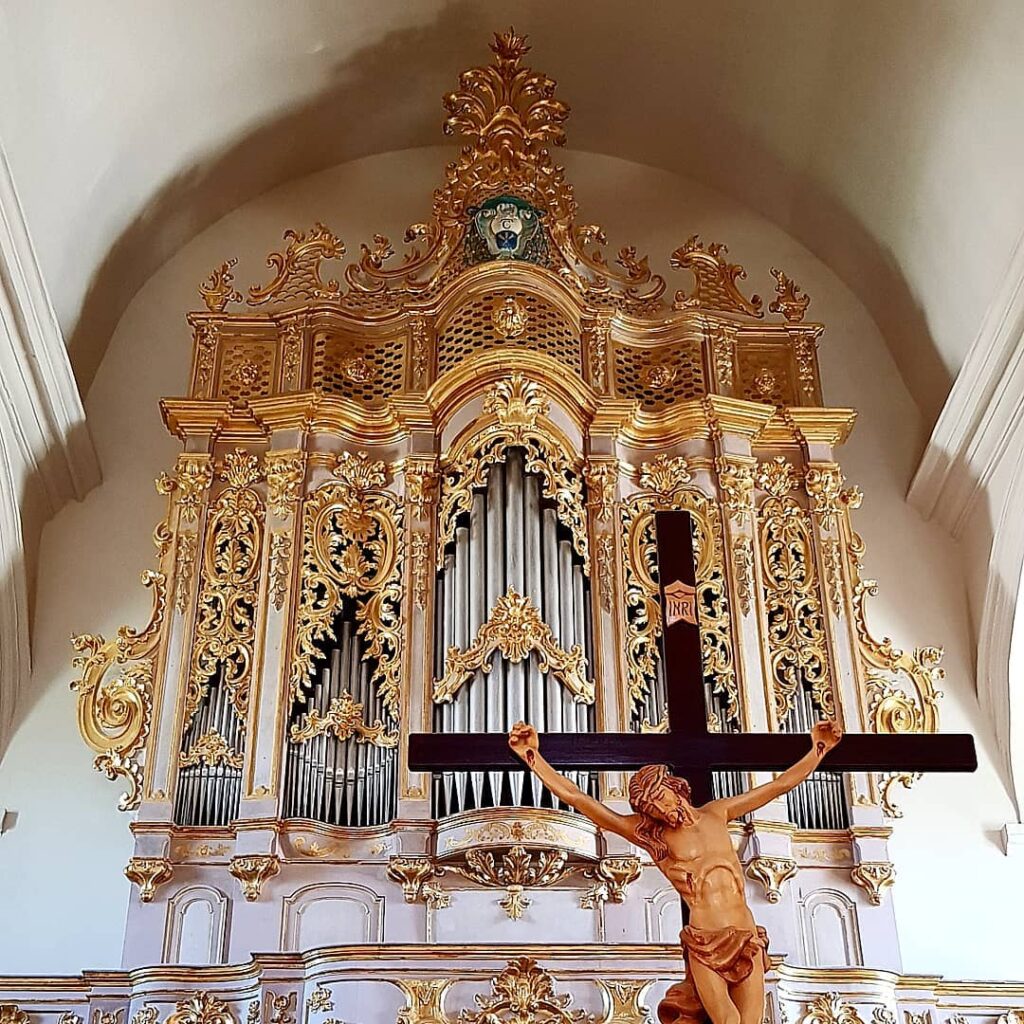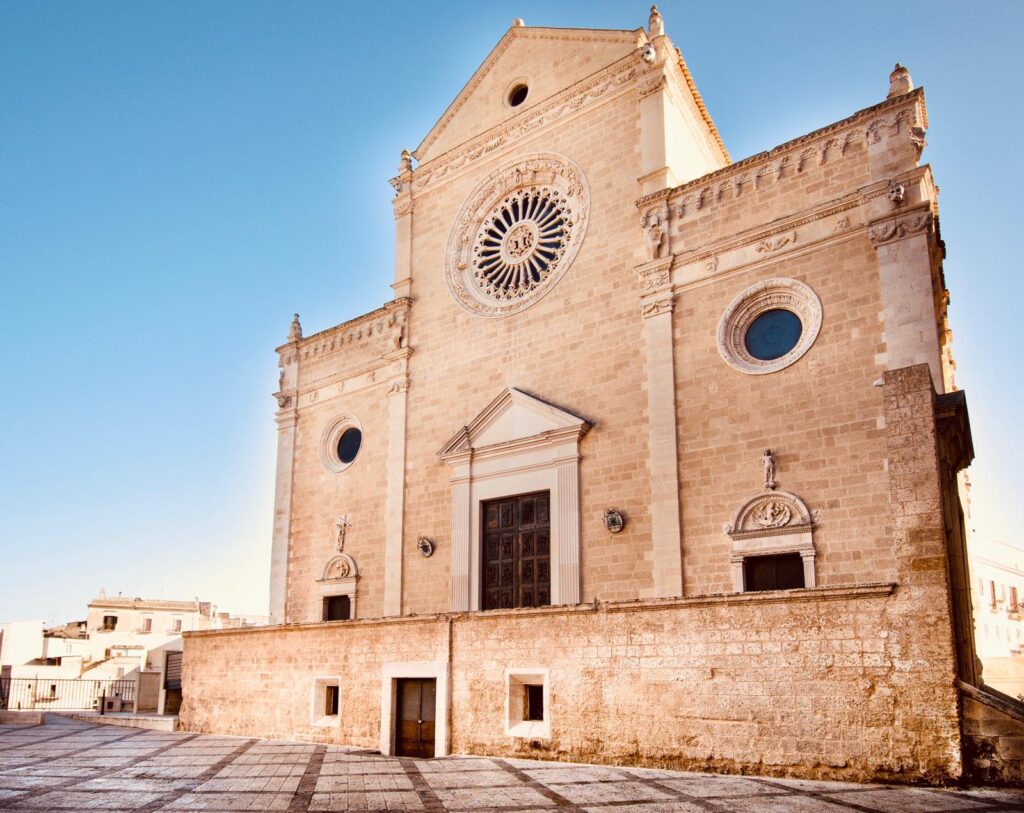Cathedral
of Santa Maria Assunta
The Cathedral dedicated to the Assumption stands on the remains of one dating back to the 11th-12th century, it was erected on the rocky edge of the Murgia canyon close to the ancient Piaggio and Fondovito districts. It was rebuilt under the bishop Matteo d’Aquino (1482-1508), according to a project of fusion between the original Romanesque and Gothic elements, with elegant Renaissance additions.
The current Cathedral has an area of m. 50 in length and m. 20 wide. While the height of the central nave is 20.90 m, that of the lateral naves is 12.70 m.
The church has three naves with two orders of 14 mazzaro columns, seven on each side, with bases and capitals in Doric and Ionic style, each one different from the other. In the central nave runs a thin carved tuff cornice with a frieze of festoons, interspersed with bas-relief cherubs. Above the cornice there are 12 windows of a fake “matronei” gallery.

CEILING
What certainly strikes the amazed eye of the visitor is the rich ceiling of the central nave, a large wooden machine that saw its execution from 1686 to 1723. Characterized by the language of the full Southern Baroque, the ceiling preserves five large canvases dated 1691 and attributed , in recent studies, to the Gravinese painter Carlo Tucci, an artist trained through the expressive language of Angelo Solimena, Francesco Guarino and Carlo Rosa.
Starting from the entrance door we find the canvas with the saints of the Orsini house, followed by the apparition to San Filippo Neri of the Virgin Mary who supports the roof of the Church of Vallicella; in the center the Assumption of the Blessed Virgin, followed by the battle of Saint Michael against the rebel angels and finally the canvas depicting the patron saints of the Kingdom of Naples, of the Bari area and of Gravina. Below it runs a frieze with medallions of saints.

ALTAR OF SAINT MICHAEL
The altar of San Michele was commissioned by the bishop M. Cavalieri in 1690, the altar has a niche decorated in fresco, inside which stands the statue of the patron saint of Gravia, San Michele Arcangelo. The group of the Saint and the dragon form a single block; the back of the sculpture is not worked. The author is Stefano da Putignano, a local sixteenth-century artist.
In the Basilica there are numerous examples of the use of polychrome marbles, in the refined frontals of the altars, sometimes there are inserts in mother of pearl and glass paste, precious and colored touches of marbles from all over the world.

ALTAR OF THE PRESENTATION OF MARY IN THE TEMPLE
A plaque on the side of the altar informs us that it was erected in 1468 by Guido de Guida and that it was consecrated by the archbishop of Taranto, Marino Orsini, as administrator of the diocese, during the period of the vacant seat in the years 1447-1471.
The bas-relief altarpiece above the altar is unique, made of Bitonto stone. There are nine paintings on three shelves. The three prophecies are depicted on the upper floor, the Virgin Mary is depicted on the central floor as she enters the Temple, received by the High Priest and followed by a procession bearing votive offerings and on the lower floor there is the presence of an old pilgrim, kneeling on the ladder.
It is probably a commission from the Angevin era, if one takes into account the Provençal instance of which the entire figurative composition is characterized.

PRESBITERAL AREA
In the presbytery area stands the triumphal arch from which hangs a rich blue stucco festoon with golden stars supported by angels. In the upper part of the arch we note the presence of the coats of arms of the card. FM Orsini with the coat of arms of the Dominicans, of Bishop Cennini and of the Cathedral Chapter.
In the Pastoral Visit of Msgr. Francesco Bossi (1568-1574) of 24 January 1574 we read that the original high altar was made of stone and located between four wooden columns. At the stroke of 1690 Msgr. Cavalieri (1690-1705) commissioned a coating with polychrome marble, as well as seven other side altars. The polychrome frontals are attributed to the hand of Francesco Cimafonte and unknown Neapolitan authors. Behind the altar there is a beautiful wooden choir in Gothic style from the 1500s commissioned by Bishop Manzolio.
Closing the presbytery area and separating the sacred space from the area set up for the faithful, there is a marble balustrade with a brass gate, which takes up the Neapolitan and Counter-Reformation tradition of distinguishing the sacred spaces within the basilica layout. The commission of the precious balustrade is due to card. Domenico II Orsini towards the end of the XVIII century.

THE ORGAN
Originally the cathedral could count in its patrimony the presence of two organs, one on the main door and the other above the great choir. The only surviving evidence of the presence of the second organ is the choir loft located at the main entrance.
A hypothesis put forward by studies believes that the organ, placed on the said door, is the one kept in the Cappellone. As for the still visible organ, we know that it was presented to the public on 28 September 1907. The realization of the graphic project was entrusted by the Chapter to teacher Francesco Amodio.

ALTAR OF SAINT FRANCIS OF PAOLA
The rear part of the last altar in the left aisle houses a glass case containing the relics of Santa Ciriaca, a Roman virgin and martyr. Enclosed in a sealed case, the remains of the saint were reassembled and modeled in wax until they resumed their human features. The design was by the neoclassical sculptor Antono Canova.
The relic arrived in Gravina on 29 June 1815.

THE OUTSIDE
The facade was rebuilt with a remarkable rose window with twenty-four rays aligned with the main portal, with the Assumption in the centre. On the sides of the main entrance two minor portals made of Bitonto stone and in the Ionic style. The lintels enclose two shells, within which two cherubs are carved in high relief; on the lintels there are two small sculptures depicting San Sebastiano on the right and the risen Christ on the left.
The entrance to the south facade is also in Bitonto stone, it is decorated with two columns with capitals, architraves, triangular frontispiece of the Doric order. On the frontispiece the image of the Madonna and Child is carved in bas-relief, while on it there are two statues: St. Peter, on the right, and St. Paul, on the left. In the center was the statue of the Risen Jesus which fell in 1900 and was reassembled by the sculptor Domenico Lorusso.


